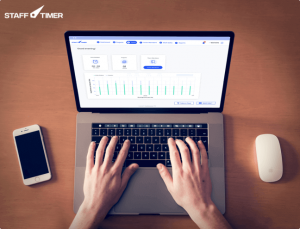Do employees work from home? Here are Top 8 Tips for Employee Productivity Tracking!
The world is facing a complete digital shift and the remote working comes with it. Also, virtual companies are getting common by the day, with teams dispersed around the globe.
This revolution brings with itself the concern for employers: Do employees work from home? If yes, are they equally productive as those in an office space? Another major question is to monitoring employees activity and productivity. Here are a few tips on how employers can perform employee productivity tracking:
8. Prioritize Work According to Ease of Completion
The first step to fully utilize the hours in an 8-hour work day. For this, it is highly important to prioritize tasks and organize them in a schedule where they can actually be carried out and completed. For instance, if there are tasks that require a remote employee to travel or communicate with some vendors, or companies, then the optimum time to carry out that task is generally in the afternoon when the workflow is prime.
On the other hand, if there are tasks that require an employee to be creative and imaginative, then the best time for that is in the early morning. Since people are most likely to have fresh minds in the morning. This would save time, and allow easy employee productivity tracking via the number of tasks completed within a day.
7. Ensure Employees Work During Company’s Work Hours
Remote work can lead to increased procrastination. Employees can tend to be more relaxed due to the heightened comfort level around them when in their own spaces. This may result in employees working on their own hours and not when every employee in the company is active.
To avoid miscommunication of tasks, and effective employee productivity tracking, we advise you to set some rules for your employees. One may be that employees working remotely must work during the company’s work hours to improve team communication and timely utilization of work produced.
For example, if a remote content writer completes content for a website at midnight, the front-end developers implement it in the morning and require changes in it, they will have to wait till the next day to get those changes in the content done.
This will delay the task itself, which should not have taken more than a few hours. Therefore, for effective employee productivity tracking, it is essential for remote and in-house employees to be active and work in unison at the same time.
6. Regular Work Intervals Allow Employee Productivity Tracking
Let’s face it, no human can remain productive for 8 or 9 hours straight. Everyone deserves a break and some relaxation time in order to be productive, deliver targets on time and relieve work stress. For efficient employee productivity tracking, it is recommended to work in short intervals.
For instance, if an employee works for 1 hour, rests for 15 minutes and again works for 1 hour, they are likely to be more productive than if they work for 4 hours non-stop and rest for 1 hour and then work for 4 hours non-stop again.
Similarly, the last person with a 1-hour break is likely to be more productive than the person who works for 8 hours straight, without any break.
Hence, regular work intervals are the best way to accurately carry out employee productivity tracking as that’s when the human mind is not over-exhausted or cluttered.
5. Draw Up a Schedule to Include Chores and Meals
The needs of employees working from home would definitely be different than the needs of employees working in-house. The best way for remote employees to stay productive is to draw up a schedule and stick to it.
Furthermore, that schedule must be created by the employer, keeping into account the fixed time for chores and meals as well.
This way, if an employee has an 8-hour work day, out of which, 1 or 2 hours are for chores and meals, then their tasks can be assigned and divided throughout the day accordingly.
4. Opt for a Comfortably Designed Workplace
Being in a comfortable environment and working in one is what makes an employee more productive in the workplace. This is something your employees need to take care of at their end.
A comfortably designed workplace helps employees in working with complete focus and dedication. Once they are focused and successfully completing the tasks assigned to them, that is when their productivity levels are at their highest.
Employee productivity tracking is made easier when the work productivity is calculated of tasks that are completed correctly and on time. A comfortable workplace, be it remote, ensures a stress-free environment and a relaxed mind for high-quality work.
3. Employee Productivity Tracking through Technology
Using technology to your own advantage helps reduce the manual work that consumes the majority of the time. Be it working productively or monitoring employees, smart work always trumps hard work. One cannot only work hard or just work smart. Both must go in unison for effective employee productivity tracking.
Employees working remotely must use automated systems and technology to reduce manual work and improve productivity. Similarly, employee monitoring in-person consumes a lot of time and even hinders the productivity of employers. A remote monitoring solution helps in saving precious minutes and allows employers to assess employee productivity accurately.
With the latest technology available these days, remote monitoring is easily possible through screen sharing, live visual logs, and automated timesheets.
2. Home Work Space is a Sanctified Place
Some rules are implemented by the company and some are self-enforced by the individual. One of the most important rules is to keep the home and office spaces separated. Your home-office or workspace at home must be a sacred place, free of interference from your family members or distractions that hinder your productivity.
Employee’s workspace must be a sanctified place where you have things organized according to your requirements. During work, employee productivity tracking is made more efficient when employees’ time is not wasted in finding relevant resources or documents in the time of need.
Less wasted time equals more time spent in actual work, hence enhanced work output.
1. Organize your Workplace and Save Useful Minutes
An organized workplace is the key to saving the maximum time during work hours. Whether you’re researching for a report or need to look at certain facts or emails, making specific folders and tagging the emails will help you locate them easily.
Similarly, using project management tools can help you save time at the time of need. The most popular tool is Google Sheets for record maintenance and organizing tasks and numbers. Employee Productivity Tracking can be made quick and easy using work organization tools.
_________________________________________________
These 8 simple tips can help you maintain a work-life balance with maximum productivity and an optimum ratio of Smart and Hard work.





